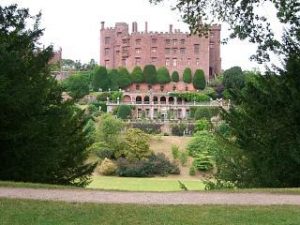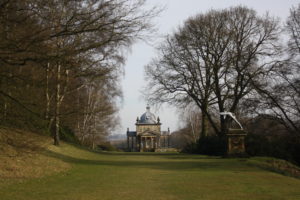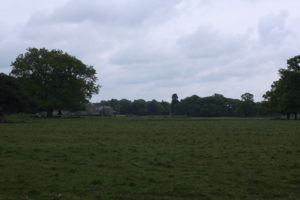07 July 2016
Brown and Green All Over
How Capability Brown rebuilt the countryside.
by J.R.Thomas
 In this wet summer of discontent, with political parties riven apart and leadership contenders knifing each other in the pursuit of power, maybe you feel it is time to retreat from the metropolitan world of shrieking headlines and urgently panting TV reporters, to read your Shaw Sheet in arcadian comfort, your back propped against a tree in some rural semi-paradise. If you are in the park of an English country house, the chances are that the relaxing greenery which refreshes and relaxes you is no accident of nature – it is probably the work of Britain’s greatest landscape gardener, Lancelot “Capability” Brown. It is the three hundredth anniversary of his birth this year – though nobody is quite sure when. Brown was never good at keeping records, even to the extent of uncertainty over his date of birth.
In this wet summer of discontent, with political parties riven apart and leadership contenders knifing each other in the pursuit of power, maybe you feel it is time to retreat from the metropolitan world of shrieking headlines and urgently panting TV reporters, to read your Shaw Sheet in arcadian comfort, your back propped against a tree in some rural semi-paradise. If you are in the park of an English country house, the chances are that the relaxing greenery which refreshes and relaxes you is no accident of nature – it is probably the work of Britain’s greatest landscape gardener, Lancelot “Capability” Brown. It is the three hundredth anniversary of his birth this year – though nobody is quite sure when. Brown was never good at keeping records, even to the extent of uncertainty over his date of birth.
We say “Britain’s” but practically all of Brown’s work was performed in England, with a little in the Welsh border counties. He seems not to have touched Scotland – probably feeling it was beautiful enough already – and famously, when asked to visit Ireland to work on a commission, said that he hadn’t “finished England yet”. There are at least 170 landscapes known to have been designed by Brown, and probably quite a number which are long lost and where Brown’s slack habits when it came to keeping records has allowed them to become forgotten. It should also be said that there are a number of landscape schemes ascribed to Brown which are not his, but may be by pupils or simply copies of his style.

Brown was born in Cambo, a Northumberland village, of an unusual marriage – his father was land agent to the Loraine family and his mother a chambermaid in service in the Loraine house. Whilst the Georgians were not perhaps as class conscious as we may think, that was an unusual alliance – land agents were usually minor sons of minor gentry or retired army officers – and we might surmise that either some rural seduction or a genuine love match, surmounting social barriers, led his parents to the altar.
His elder brother married a Loraine daughter, so perhaps it was the latter, a true romance, giving Lancelot a romantic view of Britain, which he expressed in his gardening. But at first young Lancelot seemed to have little ambition. He worked as a gardener for the Loraines, until he suddenly moved up a level and was commissioned to landscape a garden in Oxfordshire, soon thereafter moving to work for Viscount Cobham, a leading politician and owner of two great houses, Wotton Underwood and Stowe. Stowe was already perhaps the greatest landscape garden in the British Isles, masterminded by several generations of architects and designers, from Vanbrugh to Kent. In 1742 Brown took over from Kent, and Cobham allowed him to take on (and introduced to him) work from his circle of rich politician friends. By the age of 35 he was the best known garden designer in the country, soon earning the equivalent of around £1 million a year.
He was famous for his quickness in grasping the essence of the “capabilities” of land round the many great houses which he was invited to consider improving, and in sketching schemes and ideas. If they were accepted, he would bring in his own team of workers to carry out the works and planting required. Indeed, he was not just a designer of some genius, but also a clever businessman. By 1767, when he was 51, he was able to buy himself a landed estate, at Fenstanton in Huntingdonshire, and became High Sheriff of Huntingdonshire and Cambridgeshire. And in what then was (and still is) the ultimate sign of success in English society, he sent two of his sons to Eton – and one became an MP.

What made Capability so popular with his landowning clients was, as is often the way with success in design, that he caught a change of fashion at its beginning. Gardening and landscaping from the time of the Tudors until the early C18th had been formal, geometric, a discipline imposed on the land. Parterres near the house, avenues further away; great straight lines of trees that marched like Roman roads to some distant focus, whether it be a church tower or a newly constructed temple – from which views of the patron’s rolling estates might be further viewed. Brown swept so many of those rigid designs away that they are now difficult to find; one of the best (although it is actually much renewed) is St Paul’s Walden Bury in Herfordshire. Another, much vaster and original, is that surrounding Castle Howard in North Yorkshire, famous for its five mile avenue which progresses in a ruler straight line over a series of steep hills and streams.
By the 1740’s and 1750’s there had been great changes in politics and fashion to a new liberal ascendancy. Kent had first recognised that trend in gardening with his informal schemes at Stowe and elsewhere, but it was Brown who seized the tide as his own and made a liberal informality the hallmark of his gardens and his parkscapes. Lawns reached to the windows of the house, with deer or cattle roaming to the horizons. In fact, the genius of the Capability brand was to make it look as though nothing had happened, that the world outside the nobleman’s windows was a perfect arcadia, clumps of trees, rolling meadows, distant shimmering lakes, odd ruins of ancient times peeping from woods or surmounting distant hills.
But all that ageless informality was brand new. The clumps of trees were from nurseries and some at least were planted when suprisingly mature – using Brown’s special horse-drawn machines and armies of men to dig them up and move them to the new artless arcadias. Hedges were ripped out and fields grassed into parkland; lakes were streams damned discreetly out of sight, often in several places to give a long natural look. And, of course, nothing was easier than popping up an ancient ruin – with a cottage attached at the back for a gamekeeper or gardener (or for romantic trysts). Hills were made to look higher by planting informal clumps on their crowns, parks to look greater by arranging winding belts of trees and outlying little woods. When we think of the typical English landscape, what we often have in mind is how Brown remodeled the English countryside.
His projects were very expensive to carry out – but this was a wealthy age with long periods of peace at home and abroad so that the rich were becoming much richer. And, though neither the landowners nor Brown may have thought about it, once in proud possession of a landscape where Brown had developed its capabilities, the maintenance cost of heaven on earth was (and is) much lower than a formal landscape endlessly needing clipping and mowing, the gravel sweeping, new plantings made and the walls and steps repairing. That is not the least of the reasons why so many Brown landscapes have survived, though a close observer will note that many of them are nearing the ends of their lives. Dams tend to subside, lakes silt up, gales take down clumps of trees – and artificial ruins become real ones. To say nothing of the modern landowner’s urge to plough up grassland to plant potatoes, or sneak little housing estates into far corners of Lancelot’s magnificent vistas.

Fashions change; indeed even in Brown’s own time there was a reaction to his destruction of so much of what Englishmen thought of as the accepted order. The poet Richard Owen Cambridge said that he hoped to die before Brown, so that he might see heaven before it was “improved”. By the C19th century – which admired so much about Elizabethan and Jacobean architecture – Brown became derided and then almost forgotten.
It was only after the First World War that he became again admired, and one may think that was not least because of the very low outgoings of maintaining his visions, and that they could be used for sheep or dairy farming, or as at Woburn or Longleat, as ersatz safari parks. Not even Brown had considered introducing lions and wallabies as additional attractions to his version of paradise, but no doubt he would be wryly amused that the car-loads of tourists staring at the fauna of the African plains probably do not even recognise that the landscape they roam is equally artificial.
If you enjoyed this article please share it using the buttons above.
Please click here if you would like a weekly email on publication of the Shaw Sheet

